
The Sixties – science
Sixties – Science
Composition and characteristics of the airway secretions and CF factors e.g. the “Spock factor”
Science papers published in the Sixties
1961 Chernick WS, Barbero GJ, Eichel HJ. In vitro evaluation of the effect of enzymes on tracheobronchial secretions from patients with cystic fibrosis. Pediatrics 1961; 27:589-596. [PubMed]
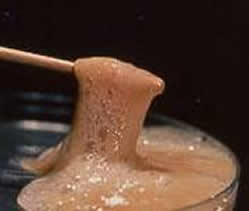
Fig 1. Viscous cystic fibrosis sputum. Author’s photo
Effect of various enzymes on the viscosity of CF sputum showed that pancreatic dornase had the most marked effect showing complete dissolution of the fibrous structure of the sputum. This finding supported the theory that the excessive viscosity of CF sputum (fig. 1) was related to a fibrous network observed in the sputum which was primarily of deoxyribonucleoproteins as had been shown by this group (Chernick et al, 1959 above).
The effect of enzymes on the sputum had been reported in other chronic pulmonary conditions (Sherry S et al. Proc Soc Exp Biol Med 1948; 68:179-184.[PubMed]) and also on CF sputum (Shwachman & Leubner, 1955 above). These and other early studies eventually led to the introduction of rhDNase (Pulmozyme) as an effective mucolytic but only after the side effects of the biological product were circumvented by producing the genetically engineered product rhDNase (Pulmozyme) (Shak et al, 1990 [PubMed] below).
Armstrong JB and White JC (Lancet 1950; 2:739. [PubMed] above) had shown that deoxyribonuclease would liquefy viscous purulent exudate; later Elmes PC & Armstrong JB (Thorax 1953; 8:295-300.[PubMed]) reported its use in chronic bronchitis, but the side effects of the bovine preparation precluded its use and further development (Raskin P. Am Rev Respir Dis 1968; 98:697-698. [PubMed]).
Shwachman (1955 above) mentions that May and Lowe used a pancreatic preparation by inhalation in one patient and that at autopsy widespread granulomatous lesions were found in the lung, a lesion not seen in any other patient.
However, eventually Shak et al (1990,[PubMed] below) cloned, sequenced, and expressed rhDNase which later became one of the major advances in treatment of the Nineties (Fuchs et al. 1994 below).
1961 Reid L. The composition of tracheobronchial secretions in cystic fibrosis. Postgrad Med J 1961; 37:599-600. [PubMed]
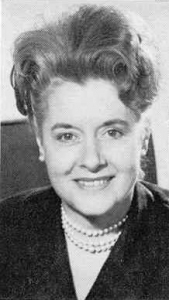
Fig 2. Lynne Reid Cystic Fibrosis Trust
Professor Lynne Reid (1923-2021) (fig. 2.) was a prominent CF researcher at the Brompton Hospital in London before she moved to the USA. Her first academic appointment was as a research assistant at the Institute of Diseases of the Chest at London University. She was appointed a professor of experimental pathology at London University in 1967, and was made Dean of the Cardiothoracic Institute at London University in 1973. Later in 1976 she accepted a position on the faculty of Harvard Medical School, as one of the school’s few women faculty members.
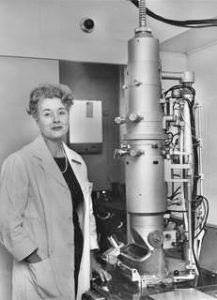
Fig 2a Lynne Reid with her electron microscope. London c.1970
Most of her publications concerned the bronchial secretions and the characteristics of bronchial mucous glands. These were popular areas for research for the few researchers involved in CF at the time, so copious and so very viscid was the sputum of people with cystic fibrosis (fig. 1). As it eventually turned out there were no intrinsic structural abnormalities of the mucus. During her time in the UK Lynne Reid was a good friend to and closely involved with the UK Cystic Fibrosis Research Trust. She reviewed much of her research in 1981 at the Minnesota Meeting (1000 Years of Cystic Fibrosis. Collected Papers. Warren J Warwick. University of Minnesota, 1981) but sadly she had to conclude that “the reason for the susceptibility of infection still eludes us”.
1962 Lieberman J. Enzymatic dissolution of pulmonary secretions. An in vitro study of sputum from patients with cystic fibrosis of the pancreas. Am J Dis Child 1962; 104: 342-348.[PubMed]

Fig 3. Jack Lieberman
Dr Jack Lieberman (Fig.3) of Los Angeles observed that a favourable effect on sputum viscosity by the addition of enzymes had been reported both in vitro (Chernick et al, Pediatrics 1961; 27:589 above) and in vivo (Shwachman et al. Pediatrics 1960; 25:155). This present study confirmed the liquefaction which occurred in the presence of various enzymes in order of effect – trypsin, ficin, chymotrypsin, deoxyribonuclease and elastase.
There was an interesting editorial comment to this article as follows – “Now if someone can find a way to bring a sufficient quantity of a non-irritating mixture of enzymes to bear on the bronchiolar mucus he can see if it works in the patient”. This did eventually occur with rhDNase (Pulmozyme) but it was to be some 30 years before this was achieved (Shack et al. 1990; Fuchs et al, 1994 both below). (Also Lieberman J. JAMA 1968; 205:312-313 below).
Dr Jack Lieberman (1926-2011) (fig.3) received his B.S. from UCLA and his M.D. from the University of Southern California in 1954. He spent many years working for the V.A. Hospital and doing research on Cystic Fibrosis. He was a Professor Emeritus for the UCLA School of Medicine and Chief of Respiratory Disease at the Sepulveda V.A.
1961 Chernick WS, Barbero GJ, Parkins FM. Studies on submaxillary saliva in cystic fibrosis. J Pediatr 1961; 59:890-898.[PubMed]
Chernick published a number of papers on the function of the salivary glands. The submaxillary saliva in CF was abnormal. Normally clear in non-CF people, the secretion in those with CF was turbid and the levels of calcium, protein and glycoproteins were increased. After injection of guanethidine the turbidity cleared and, with the exception of calcium, the increased levels of the other constituents were reversed.
1962 Holzel A, Schwarz V, Torkington P, Greville Williams GE. Mucoviscidosis and the autonomic nervous system. Lancet 1962; 1:822-823. [PubMed]
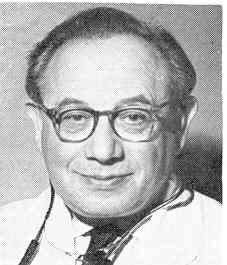
Fig 4. Aron Holzel
Dr Aaron Holzel (1909-1978) (fig. 4) was a much respected paediatrician working in the University of Manchester, England. He qualified in Prague in 1933 and came to England at the start of the war in 1939.
He published on a wide variety of paediatric subjects including CF and started the first CF clinic in Manchester. He was also involved in early meetings concerning cystic fibrosis.
Subsequent publications by other authors also described possible abnormalities of the autonomic nervous system (Davis PB et al. Pediatr Res 1978; 12:703-707; Davis PB, Kaliner M. J Chron Dis 1983; 36:269-278; Mirakhur A, Walshaw MJ. J R Soc Med 2003; 96 (Suppl.43):11-17.). However, no significant abnormalities were discovered in this area which led to further understanding of the basic defect or to any form of treatment.
1963 Denton R. The rheology of human mucus. Ann N Y Acad Sci 1963; 106:746-754.[PubMed]
This is a relevant paper as the work of Robert Denton was important in the introduction of the mist tent (see Denton 1955 above). The paper concludes with the observation that the degree of flow resistance will show as quantitatively the degree of abnormality and may provide information which can lead to further understanding of the chemical changes within the mucus blanket which are responsible for impaired bronchial drainage.
1963 Chernick WS, Barbero GJ. Studies on human tracheobronchial and submaxillary secretions in normal and pathophysiological conditions. Ann N Y Acad Sc 1963; 106:698-708. [PubMed]
The authors state – “Data relating to the tracheobronchial secretions and submaxillary saliva in cystic fibrosis indicate the high concentrations of various organic constituents which are secreted in this disease and the possible interrelationships of electrolytes on the physical properties of such constituents”.
So, as with most of these studies on the physico-chemical characteristics of the airway secretions, unfortunately there were no firm conclusions which significantly advanced understanding of the basic defect of the condition. It is interesting that these authors again mentioned the possible role of the electrolyte content of the sputum which eventually turned out to be very relevant.
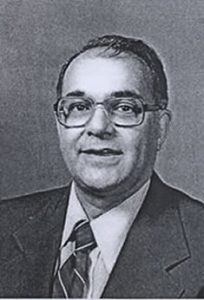
Fig 5. Giulio Barbero
Professor Giulio Barbero (1923-1997) (fig. 5) was internationally recognised for his research in CF and patient advocacy. He published extensively on CF and general paediatric topics from 1953 to 2001. He was Head of Pediatrics at the University of Missouri, Columbia from 1972-1989. He gave the third Joseph Levy Memorial Lecture at the European CF Meeting in Jerusalem in 1996 entitled “The Science and Humanity of Cystic fibrosis”.
1963 Kwart H, Mosley WW Jr, Katz M. The chemical characterization of human tracheobronchial secretion: a possible clue to the origin of fibrocystic mucus. Ann N Y Acad Sci 1963; 106:709-21. [PubMed]
One of many studies that attempted to show differences between normal and CF mucus. The authors suggest their findings appear to support the basis for the disease they had advanced earlier i.e. that the extraordinary viscidity of CF mucus was formed as a result of a defect in “membrane chemistry”. They consider that the inference is consistent with the difficulties that CF individuals experience conserving sodium chloride.
– So another group whose conclusions were not too far off the mark as it turned out. However, in contrast to the excessive loss of salt via the sweat, people with CF had a deficiency of salt in the airway secretions due to the excessive absorption of sodium and reduced passage of chloride into the airways.
1963 Matthews LW, Spector S, Lemm J, Potter JL. Studies on pulmonary secretions I. The over-all chemical composition of pulmonary secretions from patients with Cystic Fibrosis, Bronchiectasis and Laryngectomy. Am Rev Resp Dis 1963; 88:199-204. [PubMed]

Fig. 6. LeRoy Matthews.
Leroy Matthews (Fig. 6) was one of the leading clinical authorities on CF in the USA at the time. He was developing his Comprehensive Treatment Programme in Cleveland which was to become the model for CF care adopted by the CF Foundation for their Centres programme. In this study they found that total solids, DNA protein, lipid and carbohydrate were highest in CF secretions, intermediate in non-CF bronchiectasis and lowest in normals.
The marked decrease in sodium and chloride in CF sputum which they found they considered was possibly related to the infection – “if this is so it makes untenable the hypothesis that the lowered sodium and chloride content of the cystic fibrosis secretions is etiologically responsible for the disease”.
This is interesting for later the “low salt theory” was to be regarded as the most likely explanation for the alteration in the pulmonary secretions and the persisting pulmonary infection problems.
1964 Freye HB, Kurtz SM, Spock A, Capp MP. Light and electron microscopic examination of the small bowel of children with cystic fibrosis. J Pediatr 1964; 64:575-579. [PubMed]
Twenty one duodenal/jejunal mucosal biopsies were obtained from children with CF and showed normal villi and cell structure but the surfaces were covered by “a coarse fibrillar substance probably mucus” in those children who had steatorrhoea but not from the one patient that had normal fat absorption. The findings were considered to support the concept of Dische that mucus may contribute to the absorptive defect (Dische Z et al. Pediatrics 1959; 24:74-91. [PubMed]).
– These were early days for per oral jejunal biopsy in children and this was the first large study in children with cystic fibrosis. Earlier di Sant’Agnese had observed that “the histological picture on per oral biopsy is apparently normal as might be expected” (di Sant’Agnese et al. Rev Nutr Res 1961; 22:29-50). However, the present findings did not carry matters forward a great deal.
– My impression was that the intestinal villi were unusually tall in the few children with CF whom we biopsied to exclude coeliac disease.
1967 Reid L, De Haller R. The bronchial mucous glands – their hypertrophy and change in intracellular mucus. Mod Prob Pediatr 1967; 10:195-199. [PubMed]
Lynne Reid was a prominent UK researcher (Reid, 1961 details above). In 1981 she reviewed her work over the decade at the Minnesota CF meeting (Bronchial mucus and its glycoproteins in cystic fibrosis. In: Warwick WJ (Ed.). 1000 Years of Cystic Fibrosis – Collected papers. University of Minnesota. 1981:179-184).
– Although a great deal of work was carried out on the various physico-chemical properties of mucus, none appears to have had a significant effect on either the treatment or the further understanding of the basic defect – except perhaps that the increased viscosity was due to the high DNA content which was eventually improved by the use of genetically engineered rhDNase (Pulmozyme) (Shak et al, 1990 below; Fuchs et al, 1994 below).
1967 Spock A, Heick HM, Cress H, Logan WS. Abnormal serum factor in patients with cystic fibrosis. Pediatr Res 1967; 1:173-177. [PubMed]

Fig. 7 Alexander Spock
In the course of research into the effects of tobacco on the action of cilia, Dr Alexander Spock (Fig. 7) of Duke University discovered a “factor” in the serum from CF patients, which inhibited cilia beating in explants of rabbit trachea. It was reported the “factor” would cause increased mucus release as well as causing marked slowing of ciliary beating. It was present in all of 75 people with CF but not in 75 controls.
The finding received much attention around this time and was thought to be related in some way to the basic defect – perhaps abnormalities were mediated via a CF ‘anti-ciliary’ factor in the serum found to be associated with the IgG containing fractions (Bowman et al, Science 1969; 164:325-6).
Besley et al, 1969 (below) found the effect also with the gills of the freshwater mussel Dreissenia Polymorpha. Bowman et al reported the effect also occurred in oyster gill cilia (Science 1969; 164:325-6) and the effect could be reversed by heparin – the factor responsible being a cationically charged protein (Doggett RG, Harrison GM. Tex Rep Biol Med 1973; 31:685-689).
So although Spock’s report caused a great deal of interest – in all fairness, the observations did little to advance the understanding of the basic defect or treatment of cystic fibrosis.
Dr Akexander Spock (1929-2014) (fig. 8) was Chief of the Pediatric Pulmonary and Gastroenterology Division at Duke University. He was the founder of the Duke Cystic Fibrosis Center and directed the center, one of the largest in the Southeast, between 1962-1990. Although limited by a physical disability since 1990, he remained active as a mentor, consultant, and publisher. He authored or co-authored over 190 scientific publications during his career – between 1959 and 2005.
1967 Mangos JA, McSherry NR. Sodium transport inhibitory factor in sweat of patients with cystic fibrosis. Science 1967; 158; 135-6. [PubMed]

Fig 8. John Mangos
John Mangos (1932-2016)(fig. 8) was a leading CF researcher at this time. A factor that inhibited sodium transport was detected in the sweat of patients with cystic fibrosis. When the duct system of the rat parotid was perfused with sweat from patients with CF, marked inhibition of sodium reabsorption was observed. Perfusion with sweat from normal subjects caused no change in sodium reabsorption. The authors suggested that the factor may be responsible for the increased sodium concentrations in the sweat of patients with cystic fibrosis (Also Pediatr Res 1967; 1:436; Pediatr Res 1968; 2:378).
Fr. John A. Mangos, MD of San Antonio was Chairman of Pediatrics at the UTHSC-SA, as well as a Greek Orthodox Priest. During his career, he was the founder of the South Texas Aids Center for Children and Families, and founder of Providence Home and Family Services. He was also the former Medical Director of Northside Independent School District.
John Mangos recalled being called to see a patient before he had time to change out of his priest’s robes. The patient opened his eyes, saw John Mangos and exclaimed “Good heavens. I didn’t know I was that bad”!!
1968 Danes BS, Bearn AG. A genetic cell marker in cystic fibrosis of the pancreas. Lancet 1968; i: 1061- 1063. [PubMed]
Fibroblasts from many but not all patients with CF, when stained with toluidine blue, showed intracellular metachromasia. The findings depended on many factors and later there was a more detailed report by same authors (J Exp Med 1969; 129:775-793.). However, eventually no significant difference was shown between CF and normal fibroblasts (Spicer et al, 1980 Exp Mol Path 33:104).
1968 Kilburn KH. A hypothesis for pulmonary clearance and its implications. Am Rev Respir Dis 1968; 98:449-463. [PubMed]
Kilburn deduced that deep in the airways there is a tremendous amount of mucus formed probably several litres per day. But by the time the mucus reaches the trachea it has been reduced to a very small amount. So something must be happening in the small airways to absorb the bulk of this liquid.

Fig. 8a John Guy Widdicombe erjsjournals.com
Prof. John Widdicombe (1925-2011) (Fig. 8a), an eminent UK respiratory physiologist, considers this paper stimulated subsequent research and interest into how the respiratory epithelium transports water and sodium chloride.
1969 Besley GT, Patrick AD, Norman AP. Inhibition of motility of gill cilia of Dreissensia by plasma of cystic fibrosis patients and their parents. J Med Genet 1969; 6:278-80. [PubMed]
Ciliary dyskinesia factor was assayed in fresh water mussel cilia (Dreissensia Polymorpha), which proved to the most satisfactory alternative for cilia inhibition tests.
1969 Crawfurd M d’A. Experience of the cilia test for a factor in the serum of patients and carriers of cystic fibrosis. Proc. 5th International CF Conference, Cambridge Sept 1969. 42- 48.
There was great interest in the “CF factor” and Dr Martin Crawfurd, working in Leeds, studied our patients using the cilia of fresh water mussels. He obtained positive results on 11 of 12 patients with CF, 150 of 163 parents, 28 of 47 siblings and 15 of 162 controls.
Although this test was eventually abandoned, on one occasion a positive ‘cilia test’ performed by Dr Martin Crawfurd working in Leeds, caused us to persevere with establishing the diagnosis of CF in a girl aged one year whom we initially thought had Shwachman–Diamond syndrome. She had severe fat malabsorption from early infancy and the jejunal biopsy showed an entirely normal intestinal mucosal histology but the sweat tests, performed by the experienced staff at our reliable laboratory, were repeatedly normal. However, the child eventually developed an abnormal sweat test and the typical clinical features of CF; she eventually died at the age of 25 years from her pulmonary disease caused by the chronic Pseudomonas infection.

